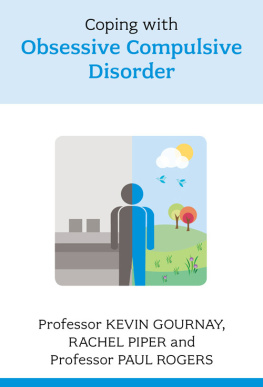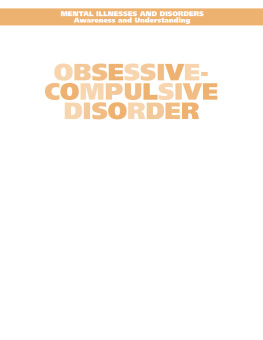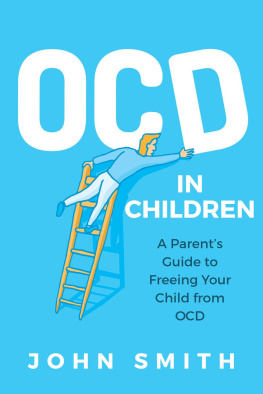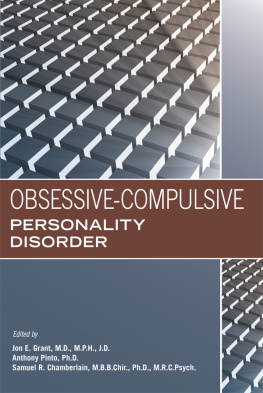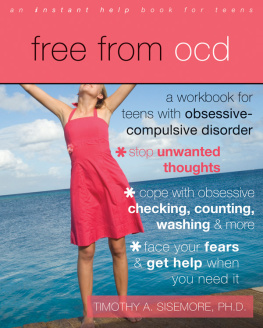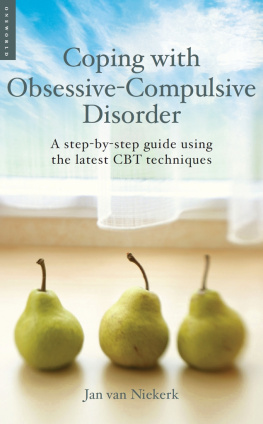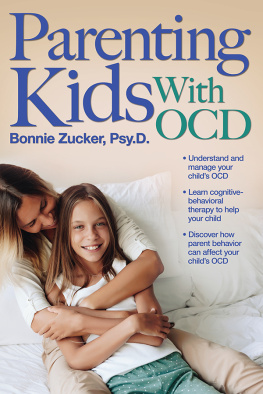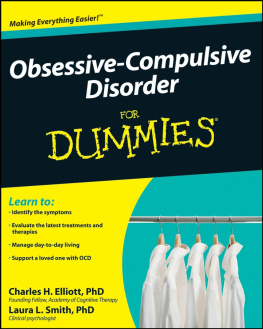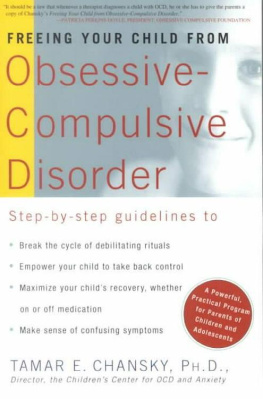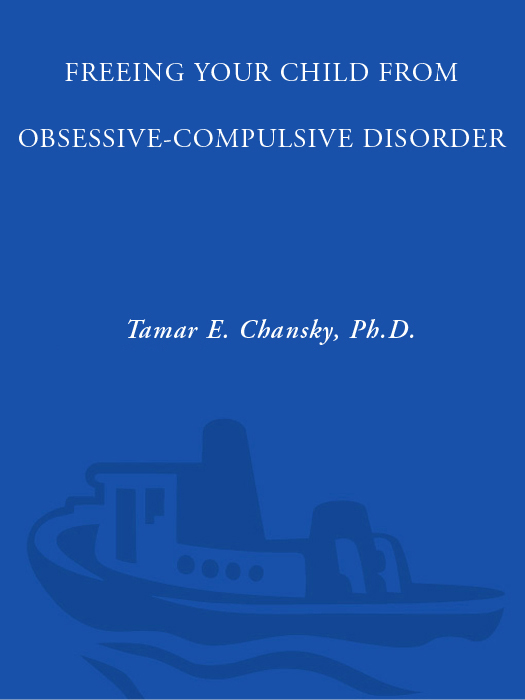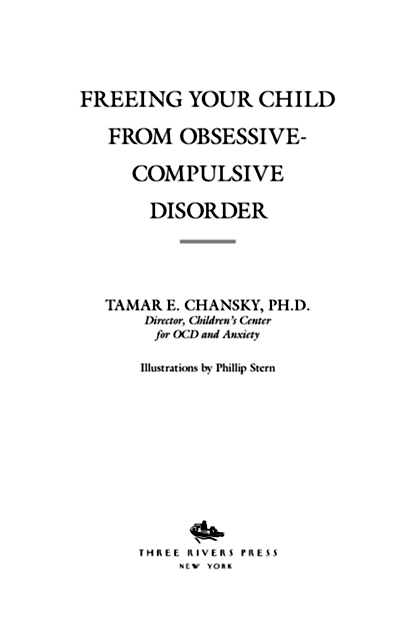Copyright 2000 by Tamar Chansky, Ph.D.
All rights reserved. No part of this book may be reproduced or transmitted in any form or by any means, electronic or mechanical, including photocopying, recording, or by any information storage and retrieval system, without permission in writing from the publisher.
Published by Three Rivers Press, New York, New York. Member of the Crown Publishing Group.
Originally published in hardcover in 2000 by Crown Publishers.
Random House, Inc. New York, Toronto, London, Sydney, Auckland www.randomhouse.com
THREE RIVERS PRESS is a trademark and the Three Rivers Press colophon is a registered trademark of Random House, Inc.
Grateful acknowledgment is made to the following for permission to reprint previously published material:
American Medical Association: Slide from L.R. Baxter, Jr., M.E. Phelps, and J.C. Mazziotta (1987). Local cerebral glucose metabolic rates in obsessive-compulsive disorder: A comparison with rations in unipolar depression and in normal controls. Archives of General Psychiatry, March, 1987, Volume 44, pp. 211218, Figure 6. Copyright 1987. American Medical Association. Reprinted by permission of the Americal Medical Association.
American Medical Association: Slide from J.M. Schwartz, P.W. Stoessel, and L.R. Baxter, Jr. (1996). Systemic changes in cerebral glucose metabolic rate after successful behavior modification of obsessive-compulsive disorder. Archives of General Psychiatry, February 1996, Volume 53, pp. 109113, Figure 1. Copyright 1996. American Medical Association. Reprinted by permission of the Americal Medical Association.
Wayne K. Goodman, M.D.: Childrens Yale-Brown Obsessive Compulsive Scale. Copyright 1986 Wayne K. Goodman. Reprinted by permission of Wayne K. Goodman, M.D.
Guilford Press: Excerpts from OCD in Children and Adolescents: A Cognitive-Behavioral Treatment Manual by John S. March and Karen Mulle. Copyright 1998 by John S. March and Karen Mulle. Reprinted by permission of Guilford Publications, Inc.
Emily Perl Kingsley: Welcome to Holland. Copyright 1987 by Emily Perl Kingsley. Reprinted by permission of Emily Perl Kingsley.
Lippincott Williams & Wilkins: Leyton Obsessional Inventory: C.Z. Berg, A. Whitaker, M. Davies, M.F. Flament, and J.L. Rapoport (1988). Journal of the American Academy of Child and Adolescent Psychiatry, 27(6), 759763, Appendix. Reprinted by permission of Lippincott Williams & Wilkins, A Wolters Kluwer Company.
Library of Congress Cataloging-in-Publication Data is available.
eISBN: 978-0-307-79444-4
v3.1
To my patients and their families for all you have taught me.
PREFACE
F or more than a decade, I have been working with children and adolescents who have anxiety and obsessive-compulsive disorder. Many of my patients have been generous enough to share their stories with me for this book. I have included them here but have disguised their and their families names and identifying characteristics to protect their privacy. I am extremely grateful to them for their candor. They shared their own experiences out of a desire to help others free themselves from the prison of OCD.
No book, including this one, can ever replace the experience of individualized care from a qualified health professional. As I emphasize here, it is essential to find a therapist who specializes in treating OCD to help you help your child. I have written this book to help you work more effectively with that therapist, to give you the tools to be effective on the home front, and to help you work with your childs school to make sure that he or she gets needed support there.
T AMAR C HANSKY
ACKNOWLEDGMENTS
I could not have started or finished this book without the inspiration, generosity, and encouragement of my patients and their families. It is to them that I give my deepest thanks and respect. They courageously let me into their lives and shared their stories with me for the cause of changing the face of OCD. From the 4-year-olds to the college students, each child has given me an opportunity to learn about life, OCD, and above all taking risks. My agent Gareth Esersky and my editor Betsy Rapoport at Crown believed in this book from the start, and were committed to bringing it to fruition. Patty Romanowski Bashe, also at Crown, contributed not only her editing expertise, but brought many important issues to my attention. Thanks to Nancy Marcus Land at Publications Development Company for bringing it all together.
Because this is a dynamic time in the study of neurobiological disorders, I was energized by the work of many colleagues. In using John Marchs innovative treatment manual, I saw how to engage childrens natural creativity and sense of healthy entitlement to win the battle against OCD. Jeffrey Schwartz inspired the idea of helping parents disengage from their childrens symptoms as he encouraged patients to do for themselves. The work of Russell Barkley and Ross Greene modeled the essential operation of teaching parents how to help their kids. John Ratey and Catherine Johnson brought to life the concept of being educated consumers when it comes to the brain. In addition, I am grateful to the many OCD experts whose commitment to the field has made a difference for millions and who directly or indirectly taught me so much especially: John Greist, Edna Foa, Lee Baer, Judith Rapoport, Jon Grayson, Fred Penzel, Herbert Gravitz, Susan Swedo, and Ian Osborn. A very special thanks to my colleagues who gave generously of their time, reading parts of the manuscript or helping me clarify my ideas: Michael Jenike, Gail Adams, Xavier Castellanos, William Hewlett, Jay Fruehling, and Matthew Cohen. Bette Hartley at the Obsessive Compulsive Information Center was truly a godsend. She not only lent her sharp eyes to the manuscript, she located and sent me every article I needed, and her unequivocal enthusiasm for the book kept me going through many a long haul. What good fortune to have as friends and colleagues, Jodi Mindell who has mentored me through the book-writing process, and DArcy Lyness, who read the manuscript and shares a vision. The OC Foundation has supported my work and the importance of the parents role. Thank you, OCF webmaster Al Willen. I appreciate the many local psychologists, psychiatrists, pediatricians, and school personnel with whom Ive had the opportunity to collaborate in the process of helping our children. The staff at the Anxiety and Agoraphobia Treatment Center gave me the freedom to grow. I thank Jeanne Marecek for encouraging me to go to graduate school and Philip Kendall for giving me so many opportunities while I was there. Mary Poovey, Donald Rackin, Jay Efran, and Michael Levine encouraged me to write.
I thank my friends who have encouraged me over the years, especially Lisa Dorothea Gillim, Nell Stoddard-Hunt, Juliet Sternberg, Margaret Horn, and Tamar Doron. Great appreciation to Shirley Brown, Sonia Voynow, Taka Suzuki, David Stoddard-Hunt, Amy Verstappen, and some guardian angels who all extended themselves with food, childcare, book runs, good wishes, and carpooling when I needed it most. Maxine Baylors loving care of Meredith was paramount in enabling me to finish my degree without too much guilt! Lee Miller is a steadfast voice of reason, and Jen Pomykcaz was heroic in her commitment to bringing me back to health. Remembering the spirit of my friend Gael Mathews steadies me.


